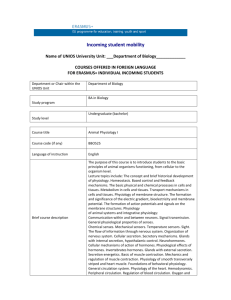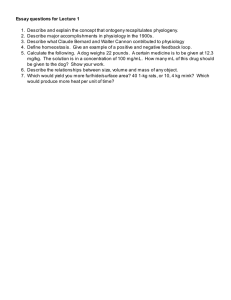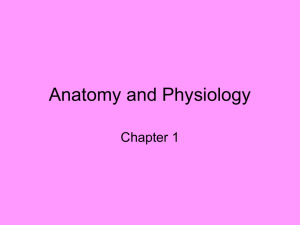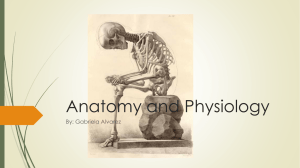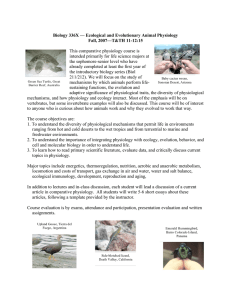PHYSIOLOGY – single paper DEGREE STANDARD
advertisement
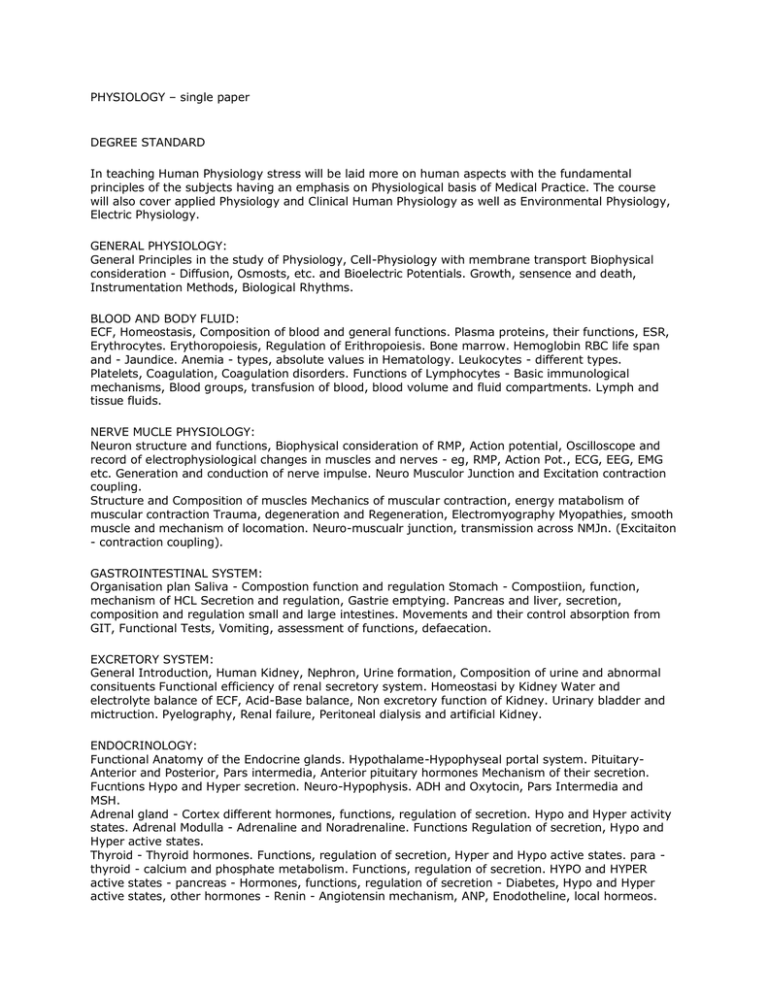
PHYSIOLOGY – single paper DEGREE STANDARD In teaching Human Physiology stress will be laid more on human aspects with the fundamental principles of the subjects having an emphasis on Physiological basis of Medical Practice. The course will also cover applied Physiology and Clinical Human Physiology as well as Environmental Physiology, Electric Physiology. GENERAL PHYSIOLOGY: General Principles in the study of Physiology, Cell-Physiology with membrane transport Biophysical consideration - Diffusion, Osmosts, etc. and Bioelectric Potentials. Growth, sensence and death, Instrumentation Methods, Biological Rhythms. BLOOD AND BODY FLUID: ECF, Homeostasis, Composition of blood and general functions. Plasma proteins, their functions, ESR, Erythrocytes. Erythoropoiesis, Regulation of Erithropoiesis. Bone marrow. Hemoglobin RBC life span and - Jaundice. Anemia - types, absolute values in Hematology. Leukocytes - different types. Platelets, Coagulation, Coagulation disorders. Functions of Lymphocytes - Basic immunological mechanisms, Blood groups, transfusion of blood, blood volume and fluid compartments. Lymph and tissue fluids. NERVE MUCLE PHYSIOLOGY: Neuron structure and functions, Biophysical consideration of RMP, Action potential, Oscilloscope and record of electrophysiological changes in muscles and nerves - eg, RMP, Action Pot., ECG, EEG, EMG etc. Generation and conduction of nerve impulse. Neuro Musculor Junction and Excitation contraction coupling. Structure and Composition of muscles Mechanics of muscular contraction, energy matabolism of muscular contraction Trauma, degeneration and Regeneration, Electromyography Myopathies, smooth muscle and mechanism of locomation. Neuro-muscualr junction, transmission across NMJn. (Excitaiton - contraction coupling). GASTROINTESTINAL SYSTEM: Organisation plan Saliva - Compostion function and regulation Stomach - Compostiion, function, mechanism of HCL Secretion and regulation, Gastrie emptying. Pancreas and liver, secretion, composition and regulation small and large intestines. Movements and their control absorption from GIT, Functional Tests, Vomiting, assessment of functions, defaecation. EXCRETORY SYSTEM: General Introduction, Human Kidney, Nephron, Urine formation, Composition of urine and abnormal consituents Functional efficiency of renal secretory system. Homeostasi by Kidney Water and electrolyte balance of ECF, Acid-Base balance, Non excretory function of Kidney. Urinary bladder and mictruction. Pyelography, Renal failure, Peritoneal dialysis and artificial Kidney. ENDOCRINOLOGY: Functional Anatomy of the Endocrine glands. Hypothalame-Hypophyseal portal system. PituitaryAnterior and Posterior, Pars intermedia, Anterior pituitary hormones Mechanism of their secretion. Fucntions Hypo and Hyper secretion. Neuro-Hypophysis. ADH and Oxytocin, Pars Intermedia and MSH. Adrenal gland - Cortex different hormones, functions, regulation of secretion. Hypo and Hyper activity states. Adrenal Modulla - Adrenaline and Noradrenaline. Functions Regulation of secretion, Hypo and Hyper active states. Thyroid - Thyroid hormones. Functions, regulation of secretion, Hyper and Hypo active states. para thyroid - calcium and phosphate metabolism. Functions, regulation of secretion. HYPO and HYPER active states - pancreas - Hormones, functions, regulation of secretion - Diabetes, Hypo and Hyper active states, other hormones - Renin - Angiotensin mechanism, ANP, Enodotheline, local hormeos. REPRODUCTION: Physiology of reproduction. Adolescence puberty, menopause, cyclin activity in females and non cyclic activity in males. Gamato genesis, Fertilisation, pregnancy, fetal sex determianiton, differentiation, parturition, lactation, population trends in India. Testis, testicular hormones, funciton and regulation. Ovary, structural function, ovulation Hormones of Ovary functions and regulation of Ovary, menstrual cycle, Physiological basis of oral contraceptives. RESPIRATORY SYSTEM: Internal and external respiration different parts of respiratory system. Mechanics of respiration pulmonary ventilation, respiratory, compliance. Surfactant, lung volumes and capacities. Alveolar ventialtion composition of different gases, dead space, uniformity of alveolar ventilation, pulmonary circulation. Ventilation/perfusion ratio; O2 and CO2 transport. Control of respiration-Nervous and chemical. Hypoxia classificaiton, High altitude phygsiology acclimatization and dyasbarsim. Gynaosis. Nonrespiratory functions of lung. Hemo respiratory and cardio vascular co-ordination and homeostasis. CARDIOVASCULAR SYSTEM: Stucture and properties of cardiac muscle, cardiac metabolism. Cardiac impulse-generation and conduction. Electrocardiography - Normal ECG, abnormal rhythems, cardia cycle-pressure and volume changes, pressure changes in the atria and ventricles. heart Sounds, Murmurs, Coronary circulation angina pectoris and coronary thrombosis. Cardiac output, regulation of cardiac output. Heart - lung prepartion - heart rate and its control capacitance and resistance vessels Hemodynamics - Methods of Measuring blood flow - circulation time. Blood Pressure - Physilogical Variation - Regulation of B.P Cardiovascular changes - changes during exercise, cerebal circulation placental and fetal circulation. Venous circulation - cutaneous circulation - Hypertension and hypotension - Heart failure - hemo-dynamics in heart diseases. ENVIRONMENTAL PHYSIOLOGY: Environment, definition - skin, structure and function, temperature regulation - fever, response to cold environment hypothermia, altitude and space physiology - Hyderbaric environment, environmental pollution. NERVOUS SYSTEM: General features of the nervous system - structural and functional organisation - neurones, CSF Barrier mechanisms, synapse and synaptic transmission. SENSORY MECHANISM: Receptors, classification - Ascending pathways - Thalamus and its functions. Thalamus nuclei, thalamic syndrome cerebal correxsensory, motor areas - investigative techniqeus pathophysiology of pain, visceral and referred paid - mechanism of head ache - lower motor neurone - reflexaction - properties and significance - stretch refix - spinalcord and brain stem reflexes - muscles spindle supporting reactions - reticular formation - organisation, connection and functions, Cerebrellum projections localisation and functions - cerebraller leeions - basal ganglai, functions - motor areas corticopsinal tracts - regulation of tone, posture and equilibrium - locomotion and skilled movement - lesions of spinal cord, brain stem - lower motor neurones - autonomic nervous system - hypothalamus connections and functions - limbre system - functions conditioning - learning and habit formation speech and speech disorders - EEG-Sleep, dreams and disorders of sleep motivation, emotions and intellectual functions. SPECIAL SENSES: Eye-Introduction - anatomy of the eye-introcular fluids and pressure - errors of refraction - Schematic eye-movements of eye ball-strabisum - photoreceptor mechanism - retina functions of retina - photochemistry - colour vision - electro retinogram-visual pathway visual reflexes - visual defeccts and their evaluation - lesions of the visual pathway. EAR: Anatomy of the ear-sound transmission through external ear-middle-ear-protective reflex - physiology of internal ear. Transmission of sound ways in cochela-auditory pathways, and central mechanism of hearing deafness and test of hearing, audometry-vestibular mechanism-functions sense of taste and flavours mechanism of tests perception-sense of smell and appreciation dismen.
